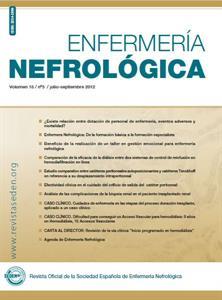Contenido del artículo principal
Resumen
La dosis de diálisis es un elemento fundamental en la diálisis adecuada y en la supervivencia del paciente. Entre los elementos que infl uyen en la misma destacan: tiempo, flujo sanguíneo (Qb), coeficiente de transferencia de masa de urea (KoA) y fl ujo del baño (Qd). El objetivo es evaluar si con Qd 800 ml/min y tiempo programado 240 minutos conseguimos mayor eficacia que con Qd 500 ml/min y tiempo programado 240 minutos y con Qd 500 l/min y tiempo efectivo 240 minutos.
Pacientes y métodos
Estudio prospectivo sobre población prevalente en hemodiálisis, con criterio de inclusión pacientes mayores de edad en hemodiafi ltración on-line postdilucional con flujo sanguíneo adecuado.
En cada paciente se realizan 18 sesiones consecutivas variando Qd y tiempo con siguiente esquema:
Fase 1: 6 sesiones con Qd 800 ml/min y tiempo programado
240 minutos.
Fase 2: 6 sesiones con Qd 500 ml/min y tiempo programado
240 minutos,
Fase 3: 6 sesiones con Qd 500 ml/min y tiempo
efectivo 240 minutos.
El análisis estadístico se realiza mediante SPSS 13.0 para Windows.
Las variables cuantitativas se expresan como media, desviación estándar y rango. Las variables cualitativas, como frecuencia y porcentaje.
Resultados
Analizamos 432 sesiones obteniendo Kt y Volumen total de reinfusión (VTR) mayores en la fase 3 del estudio con respecto a las otras dos, no existiendo diferencias signifi cativas entre la fase 1 y 2.
Discusión y conclusiones
No existen diferencias en la efi cacia dialítica entre Qd 500 ml/min y Qd 800 ml/min, mientras que con el aumento de 10 minutos de media en cada sesión, se incrementa la dosis de diálisis en 2,77 litros y el VTR en un 9%, reduciendo a la mitad el número de pacientes que no logran los 20 litros de volumen de reinfusión. Y esto, con un menor coste adicional especialmente por las diferencias de envasado del bicarbonato.
Pacientes y métodos
Estudio prospectivo sobre población prevalente en hemodiálisis, con criterio de inclusión pacientes mayores de edad en hemodiafi ltración on-line postdilucional con flujo sanguíneo adecuado.
En cada paciente se realizan 18 sesiones consecutivas variando Qd y tiempo con siguiente esquema:
Fase 1: 6 sesiones con Qd 800 ml/min y tiempo programado
240 minutos.
Fase 2: 6 sesiones con Qd 500 ml/min y tiempo programado
240 minutos,
Fase 3: 6 sesiones con Qd 500 ml/min y tiempo
efectivo 240 minutos.
El análisis estadístico se realiza mediante SPSS 13.0 para Windows.
Las variables cuantitativas se expresan como media, desviación estándar y rango. Las variables cualitativas, como frecuencia y porcentaje.
Resultados
Analizamos 432 sesiones obteniendo Kt y Volumen total de reinfusión (VTR) mayores en la fase 3 del estudio con respecto a las otras dos, no existiendo diferencias signifi cativas entre la fase 1 y 2.
Discusión y conclusiones
No existen diferencias en la efi cacia dialítica entre Qd 500 ml/min y Qd 800 ml/min, mientras que con el aumento de 10 minutos de media en cada sesión, se incrementa la dosis de diálisis en 2,77 litros y el VTR en un 9%, reduciendo a la mitad el número de pacientes que no logran los 20 litros de volumen de reinfusión. Y esto, con un menor coste adicional especialmente por las diferencias de envasado del bicarbonato.
Palabras clave
Hemodiafiltración On-line; Flujo de líquido de diálisis; KT; Dosis de diálisis; Tiempo de sesión.
Detalles del artículo
Licencia
Aviso de derechos de autor/a
© Los autores ceden de forma no exclusiva los derechos de explotación de los trabajos publicados y consiente en que su uso y distribución se realice con la Licencia Creative Commons Atribución - No comercial 4.0 Internacional (CC BY-NC 4.0). Puede consultar desde aquí la versión informativa y el texto legal de la licencia. Esta circunstancia ha de hacerse constar expresamente de esta forma cuando sea necesario.
Cómo citar
1.
Aznar Barbero S, Bel Cegarra R, Badallo Mira MM, Pagán Escribano D, García Nicolás AB. Estudio comparativo en pacientes en Hemodiafiltración en línea postdilucional de alta eficacia con diferentes flujos de líquido dializante, tiempo programado y tiempo real. Enferm Nefrol [Internet]. 2013 [consultado 19 Dic 2025];16(3):[aprox. 6 p.]. Disponible en: https://www.enfermerianefrologica.com/revista/article/view/4193




